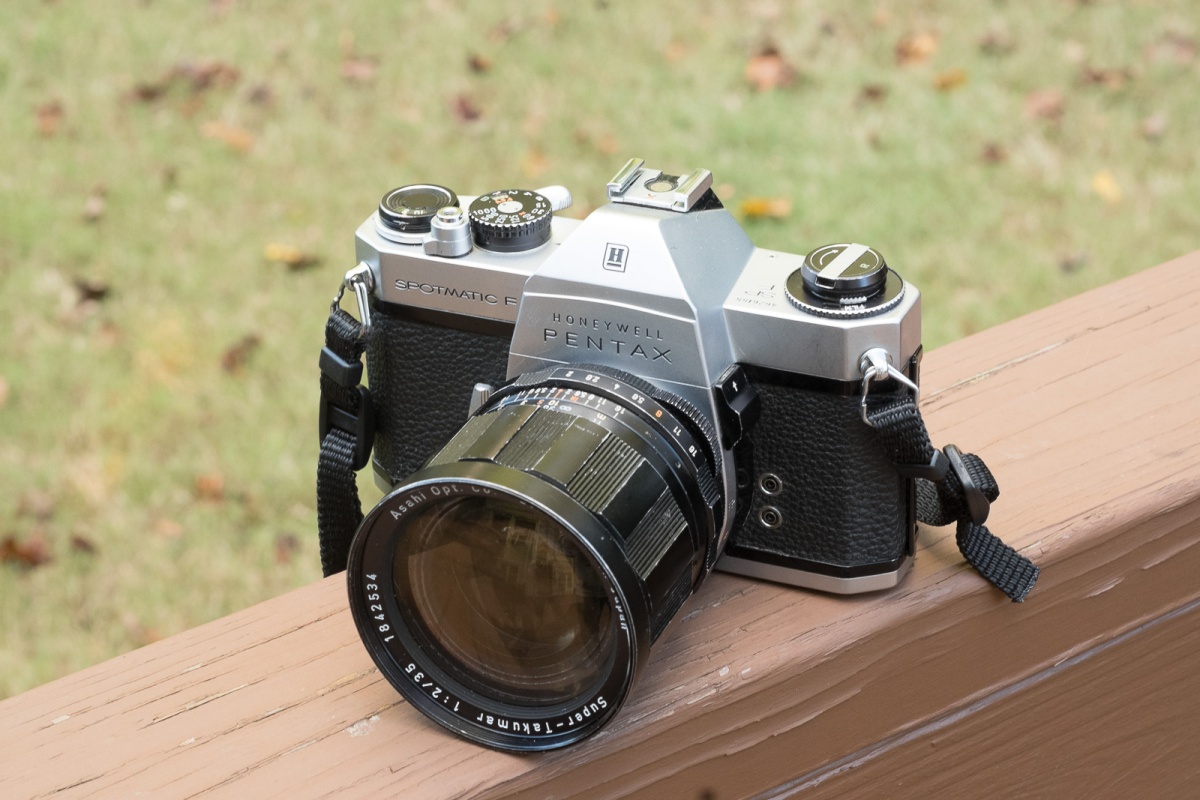The “standard” Asahi Pentax Spotmatic is a camera I would have loved to like. I was attracted to its small size, its nice finish and its pleasant design. The Spotmatic was a camera of high historical significance – the first mass market SLR with Through The Lens (TTL) metering and a best seller in the sixties (the first Japanese SLR to sell in excess of one million units). Last but not least, my first reflex camera and my first dSLR were both Pentaxes and I’ve always had an affinity for the brand. All good reasons to add a Spotmatic to my ever expanding collection.

The first one I bought, although superb on the pictures, had a broken shutter. The second one had a capricious rapid wind lever, a shutter release with an enormous lag, a very stiff exposure meter lever, and a meter of uncertain accuracy. I did not trust it and never loaded a single roll of film in it. Those little cameras, as cute as they were, did not seem to have been built like the Nikon SLRs of the same vintage (two of the three cameras I bought recently had the sticker of a camera repair shop in the film chamber).
But I kept on reading nice things about the Spotmatic, and I decided to give it another try. A last chance. This time my pick was the final camera of the Spotmatic family, the full aperture metering Spotmatic F.
Full aperture metering, at last
With the model “F” launched in 1973, Pentax finally brought full aperture metering to its line of semi-automatic cameras, more than seven years after Minolta and Nikon had opened the way with the SRT 101 and the Nikkormat, and two years after Canon, Olympus and Fujica had finally adopted full aperture metering.
More about Full Aperture and Stopped down metering

On the outside, nothing had changed. The same compact dimensions, the same pleasant design with the “Pentax touch” – such as a red indicator showing that the shutter is cocked. The only major difference inside was of course that the “F” was a full aperture metering camera.
The Spotmatic F is still compatible with normal 42mm screw mount lenses with aperture pre-selection (Pentax Auto-Takumar, Super-Takumar, as well as hundreds of lenses sold by competitors), but full aperture metering requires the use of the new Super-Multi-Coated (S-M-C) Takumar lenses. Introduced with the Pentax Electro-Spotmatic of 1971 (the first aperture priority automatic exposure SLR with an electronic shutter), the S-M-C lenses remain backwards compatible with the 42mm standard, but add a prong to transmit the value of the pre-selected aperture from the lens to the camera body (this variant of the 42mm universal mount is sometimes named Pentax ES).[*]

The Spotmatic F had a short sales run, but a very long legacy. It was superseded after less than 2 years by the new line of Pentax K bodies (KM, KX and K2).
To a large extend, the K bodies were a limited refresh of the Spotmatic design – modified to support the new K bayonet mount and silver oxide batteries; the KM in particular was extremely close technically to the Spotmatic F. All three models were rapidly replaced with a new line of more compact cameras (the MX and ME), but the K1000 (a simplified version of the KM introduced in 1976) remained in the catalog until 1997.
Using the Spotmatic F
It’s a compact camera (much smaller than the Canon FTb or the Nikkormat, almost the same size as a Nikon FM), but it’s surprisingly heavy at approximately 650g without the lens. The fit and finish are in line with Pentax ‘s tradition, which means very good, even if not at the level of Nikon.
- Viewfinder – it’s correct for a camera of that vintage, but is clearly not as bright and clear as the viewfinder of the Olympus OM-1, or of cameras that came to the market only a few years later (Nikon FM , for instance). And it’s lacking the split-prism present in its more modern rivals (the viewfinder only shows a small ring of micro prisms. Getting the focus right is not as easy as it should be).
The relatively long eye point makes it usable by photographers wearing glasses – they will just have to be aware that if they want to frame precisely, they will have to look up, down, left, right. As mentioned earlier, focusing is sort of OK with a fast, full aperture capable lens. But with standard m42 lenses, metering is stopped down, and when an aperture narrower than f/5.6 is selected, the focusing screen becomes too dark for composing (the right sequence is compose, focus, lift the metering lever, adjust the exposure, press the shutter release). - Metering – the Spotmatic F is a conventional semi-auto camera, with the needle at the right of the viewfinder. Full aperture metering is more comfortable, but the Spotmatic F can also be used with older Super-Takumar lenses (or any m42 lens), stopped down. The Spotmatic F I bought was in very good shape, and the stopped down lever (at the left of the lens flange) moves very smoothly; it makes a faint “click” when it reaches the stopped down position.
- Battery: Another difference with earlier Spotmatics is that the “F” used PX625 Mercury batteries, larger than the diminutive RM640 battery used previously. Of course Mercury batteries can not be found anymore, but the Spotmatic has the reputation of being very tolerant with all sort of batteries – mine is apparently fitted with an Alcaline-Manganese battery, a PX625a, and the metering is still spot-on.
- Lens selection: only Pentax lenses sold after 1971 benefit from the modified lens mount supporting full aperture metering on the Spotmatic F (there are exceptions here and there – for more information check this page: https://cameragx.com/2017/10/26/the-pentax-m42-lenses/). In my opinion, the main reason to buy a Spotmatic F (over an older SP or a SP II) is full aperture metering – even if standard m42 lenses are perfectly usable.
So, what are the options?- buy a Pentax Super-Multi-Coated lens, but the selection is limited to prime lenses, and the product line stopped being updated in 1975;
- or find a third party lens compatible with the modified Pentax mount (Tamron Adaptall lenses come to mind – there is a specific Adaptall mount for the Pentax ES series, and Tamron offered Adaptall lenses until the end of the XXth century).
All in all, the “F” is a pleasant, compact, well rounded camera. The viewfinder is a bit of a let down, but compared to what was available in 1973 from the other big vendors (Nikkormat, Canon FTb, Minolta SR-T), the “F” more than holds its rank: it is less bulky than any of the other three, and is simpler to use than the Nikkormat. Of course, the Olympus OM-1 was much more compact, the Fujica ST801 was more advanced technically, and both had a better viewfinder – but if you absolutely want a m42 screw mount camera from the early seventies, it’s a very good pick.

Should you buy a Spotmatic F?
When you buy a single lens reflex camera, you buy into a system. If you’re committed to m42 screw mount lenses, the Spotmatic F is a very good choice. It’s a simple, easy to use semi-auto camera, it offers the comfort of full aperture metering, its Takumar lenses have an excellent reputation, and almost any m42 lens can be mounted on the camera.
But you also have to consider that for the Pentax m42 system, the end was close when the Spotmatic F was launched: this camera is the best and final iteration of the Pentax m42 family, a system with its roots in the late fifties. The lens selection was frozen forever in 1975, and there is no upgrade option beyond the “F”. It may not be an issue for you if you’re happy with the technology of the SLRs of the early seventies, and don’t want to have anything to do with programmed auto-exposure, spot metering, fast shutters, long eye point viewfinders, acute matte focusing screens, TTL flash systems and good trans-standard zooms.
In 1973, manual focus SLR systems had not reached their peak yet – a few pretty good cameras and more than a few pretty good lenses would still be launched during the following 15 years. For a photographer interested in investing in a manual-focus camera system, there may be better choices than the m42 system, starting with Pentax’s own K bayonet SLRs of 1975 and beyond.
How much?
Spotmatic cameras (of any type) in perfect working condition are definitely not members of my league of the $5 cameras. The Takumar lenses are relatively abundant and have a great reputation, which contributes to Spotmatic’s high usage value. It’s been more than forty years since the last Spotmatic was manufactured, and they seem to require more care and maintenance than equivalent cameras from other brands. Although they were manufactured in large quantities (3.6 million over a 12 year production run) the supply of good copies is starting to dry, driving the sales price up.
The Spotmatic F is not as common as the older stopped down Spotmatics (approximately 600,000 units were sold in 3 years), and it is slightly more expensive. Expect cameras in perfect working order to be in the 50.00 to $75.00 bracket.
[*] no rule without an exception – the Super-Takumar lens that came with this particular camera is using the “ES” version of the m42 mount, and supports full-aperture metering. It was Pentax’s entry-level kit lens in the early seventies, and probably to keep its cost in check, Pentax deprived it from the “Super-Multi-Coating” treatment.
More about the line of Pentax Spotmatic cameras:
- A blog mainly focused on Asahi Pentax cameras with a Penta-Prism viewfinder: http://www.pentax-slr.com
- A blog dedicated to manual focus cameras: https://www.678vintagecameras.ca with a very informative page about Pentax cameras and lenses
- For people who love statistics, an estimate of the sales volumes of the cameras of the 70s-80s by brand: http://knippsen.blogspot.ca/

One thought on “Pentax Spotmatic F”
Comments are closed.